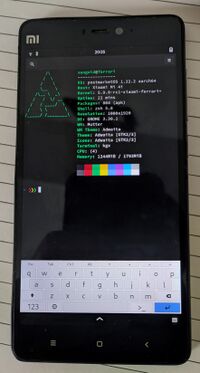Xiaomi Mi 4i (xiaomi-ferrari)
Appearance
| This page is about the dedicated port of this device. There is also an optional generic port available for this device - see Generic MSM8916 (qcom-msm8916). |
| This device runs a Downstream kernel. Some UIs will not work, and most features (3D acceleration, audio, etc.) may be broken. |
 Mi 4i running Phosh with (close-to-mainline) kernel | |
| Manufacturer | Xiaomi |
|---|---|
| Name | Mi 4i |
| Codename | xiaomi-ferrari |
| Released | 2015 |
| Type | handset |
| Hardware | |
| Chipset | Qualcomm Snapdragon 615 (MSM8939) |
| CPU |
Octa-core (4x1.7 GHz Cortex-A53 4x1.0 GHz Cortex-A53) |
| GPU | Adreno 405 |
| Display | 1080 x 1920 IPS LCD |
| Storage | 16/32 GB eMMC 4.5 |
| Memory | 2 GB |
| Architecture | aarch64 |
| Software | |
Original software The software and version the device was shipped with. |
Android (MIUI) 5.0.2 |
Extended version The most recent supported version from the manufacturer. |
Android (MIUI) |
| postmarketOS | |
| Category | downstream |
Mainline Instead of a Linux kernel fork, it is possible to run (Close to) Mainline. |
no |
pmOS kernel The kernel version that runs on the device's port. |
3.10.104 |
Unixbench score Unixbench Whetstone/Dhrystone score. See Unixbench. |
2246.4 |
| Optional Generic Port | Generic MSM8916 (qcom-msm8916) |
| Device package |
|
| Kernel package |
|
Flashing Whether it is possible to flash the device with pmbootstrap flasher. |
Works
|
|---|---|
USB Networking After connecting the device with USB to your PC, you can connect to it via telnet (initramfs) or SSH (booted system). |
Works
|
Battery Whether charging and battery level reporting work. |
Untested
|
Screen Whether the display works; ideally with sleep mode and brightness control. |
Works
|
Touchscreen |
Works
|
| Multimedia | |
3D Acceleration |
Works
|
Audio Audio playback, microphone, headset and buttons. |
Untested
|
Camera |
Untested
|
| Connectivity | |
WiFi |
Works
|
Bluetooth |
Untested
|
GPS |
Untested
|
| Modem | |
Calls |
Untested
|
SMS |
Untested
|
Mobile data |
Untested
|
| Miscellaneous | |
FDE Full disk encryption and unlocking with unl0kr. |
Untested
|
| Sensors | |
Accelerometer Handles automatic screen rotation in many interfaces. |
Untested
|
| This device is based on the Snapdragon 615. See the SoC page for common tips, guides and troubleshooting steps |
Contributors
Maintainer(s)
Users owning this device
- JuniorJPDJ (Notes: half broken touch)
- Sungold (Notes: No longer with me, dead speakers and display, stopped mainline development)
- TQMatvey (Notes: half broken touchscreen)
How to enter flash mode
Recovery mode
- Turn the device off (or restart also works)
- Hold and button
- Once you feel vibration and phone turns on, release button
- Keep holding until you get to recovery.
Flashing (Download, Fastboot) mode
- Same as recovery, but this time hold the and keys.
Installation
- Install pmbootstrap first on your PC
- zap & reinit pmbootstrap (
pmbootstrap -y zap ; pmbootstrap init), choosexiaomi-libraas device - proceed with installation as usual: reboot device to fastboot mode, then:
pmbootstrap install pmbootstrap flasher flash_kernel pmbootstrap flasher flash_rootfs
See also
- pmaports!1207 Initial merge request
- Mainline Repo